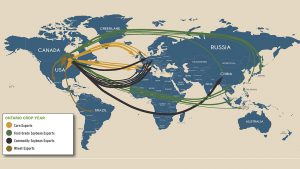GM food decisions
UNDERSTANDING THE CANADIAN CONSUMER

WITH GROWING URBANIZATION and fewer than two per cent of the Canadian population working in agriculture, Canadian consumers are generally removed from agriculture and this distance is hard to bridge. There is a gap in acceptance of genetically modified (GM) technology between experts and non-experts documented for GM foods.
A 2016 Health Canada report, “Consumer Views of Genetically Modified Foods,” found that average Canadians surveyed had overall negative impressions associated with GM foods, one of which was grains. GM technology is important to Ontario grain farmers as approximately 89% of grain corn grown in Ontario in 2018 was GM and approximately 76% of the soybean crop grown in Ontario in 2018 was GM (StatsCan, 2019). The first step to communicating the benefits of GM foods to consumers is to take the time to understand the Canadian consumer’s perspective.
This is exactly what Emma Burger, a master’s of science student in Food, Agricultural and Resource Economics at the University of Guelph, is investigating with her research project. She is examining the role emotions play in Canadian consumers’ perception of GM foods and is supervised by Dr. Andreas Boecker. Previous studies have shown that when strong emotions are present, technology evaluation and the relationship between risks and benefit perception is affected. This is important, because the ratio of risk to benefit perception is used as a predictor of technology acceptance.
INTEREST IN AGRICULTURE
Burger grew up in the suburbs of Cambridge, so stories from her grandmother who grew up on a farm and the mainstream media were her sources of information about where food comes from.
“I became interested in agriculture because of its coverage in the media. Looking to understand more about where my food was coming from, I started attending farmers markets and eventually enrolled in the BSc. Agricultural science at the University of Guelph,” explains Burger.
Through her courses, Burger was able to learn about agricultural technologies and decisions made by farmers. After taking an agricultural economics course, she decided to switch to a commerce degree specializing in Food and Agricultural Business.
Burger’s current research project takes concepts from economics and psychology into consideration to form a better understanding of Canadian consumers’ perceptions of GM food.
“The topic of GM food is interesting to me because GM technology can have many uses, there has been evidence that using GM food is associated with increased farm incomes, and it is also the topic of a polarized debate,” says Burger.
BEHAVIOURAL ECONOMICS
Several decades of research on risk perception and communication have shown that experts (e.g. academics) assess risks very differently than non-experts, in the case of Burger’s research, consumers. While experts weigh a new technology’s benefits and risks with their respective probabilities and severity, consumers lack this information. Therefore, the consumer’s assessments are guided by factors such as familiarity, catastrophic potential, perceived control to avoid a hazard, as well as values, beliefs, and trust in their country’s institutions and regulatory bodies.
Her research builds off these studies and also includes elements from economic analysis of decision making under risk and uncertainty, such as risk attitudes and tolerance to incomplete information. This places her research in the field of behavioural economics, which uses concepts from other disciplines, mostly psychology, to investigate human behaviour that deviates from the predictions of the expected utility model of economic theory. Behavioural economics has been used in research to evaluate consumer perception and consumer choices with other technologies, such as nuclear energies and GM food decisions in other countries.
The main application of her research is to inform and improve science communication to the Canadian consumer about GM technologies. Her research is part of two projects on agricultural biotechnology communication that have been funded by the Ontario Agri-food Innovation Alliance.
A set of communication best practices and an editing tool for reviewing existing communication have been developed based on previous research. Insights from Burger’s research will contribute to revising and enhancing these practical communication guides. For example, knowing which statement types about GM food evoke strong negative or positive emotions could be used to reduce barriers to engaging with the public about this controversial topic.
For those farmers who are communicating directly with consumers, the revised best practices guide and editing tool can be useful in how they address agricultural biotechnology. For the farming sector in general, Burger’s research can be seen as a contribution to balancing the public conversation, so that GM technology remains available in the future and is not effectively banned despite available scientific knowledge, as has happened in the European Union.
Emma Burger and Dr. Andreas Boecker gratefully acknowledge funding from the Ontario Agri-food Innovation Alliance for this research project. •





















